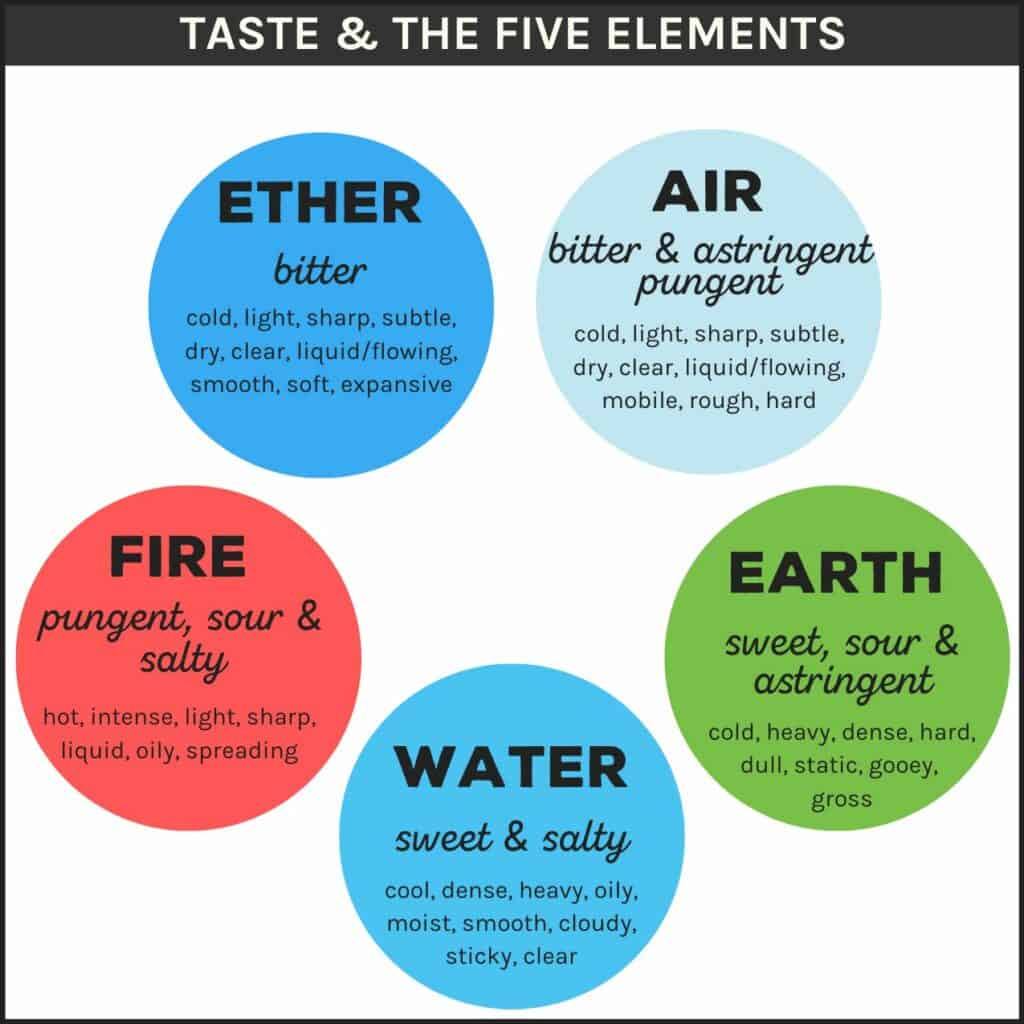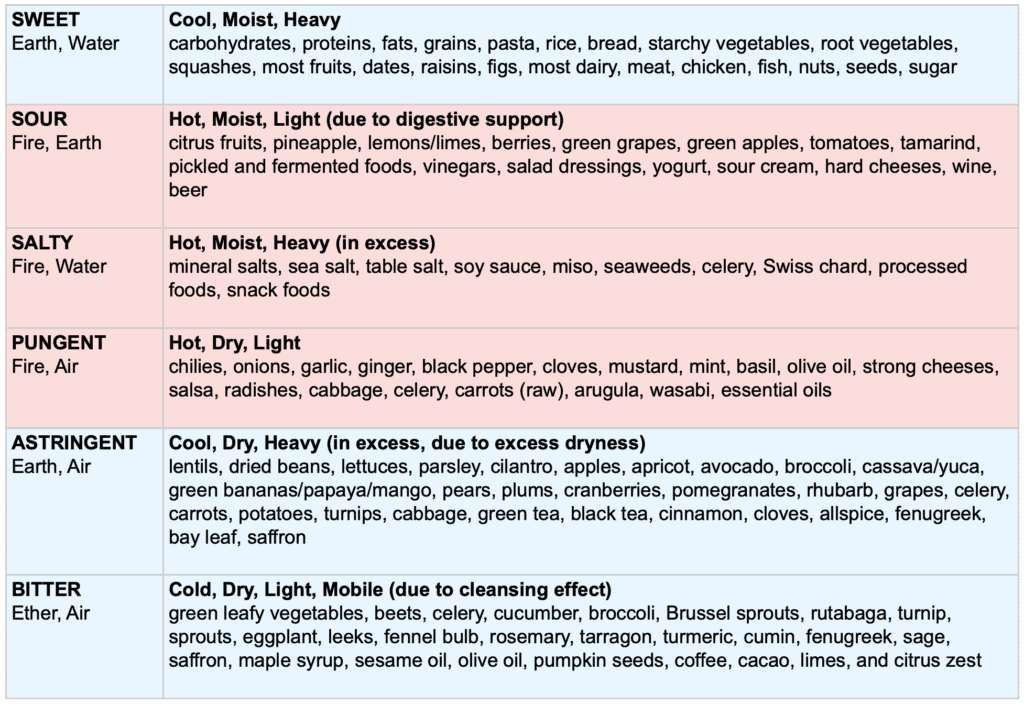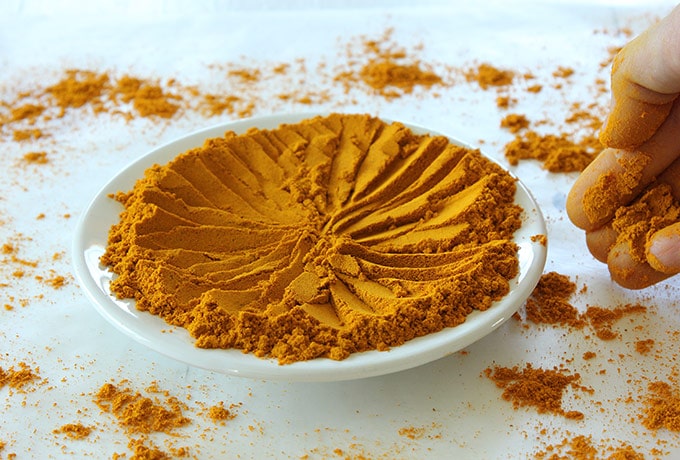From ancient times to today, the Six Tastes of Ayurveda have remained relevant to our lives as a source of healing.
The basic principle is simple: balance the six tastes of sweet, sour, salty, bitter, pungent, and astringent in your meal, and you are guaranteed to experience satisfaction while eating.

I say this from personal experience, as I have cooked according to the Six Tastes for over 25 years, and experienced profound inner joy and satisfaction from my food as a result.
How does it work?
The enormous satisfaction one feels when a meal is balanced according to the Six Tastes comes from the fact that the Six Tastes contain the entirety of the universe.
In Ayurveda, the universe is said to consist of just five elements, which are Air, Ether, Fire, Water, and Earth.
Then each of the six tastes is made up of a combination of two elements.
- Sweet: Water and Earth
- Sour: Fire and Earth
- Salty: Fire and Water
- Bitter: Ether and Air
- Astringent: Earth and Air
- Pungent: Fire and Air

The idea here is that when you consume some of each taste in your meal, your body gets everything it needs, and that's what helps you to feel completely satisfied.
There is a further correlation between the elements and your emotions, which means your mind and heart are also fully nourished.
Put in the simplest terms though, a balance of the six tastes on your plate tastes—and feels—incredible to eat.
Check out my testimonials to read what others are saying too.)
Want to learn how to get yourself some tasty food and maybe even bliss out?
Below are the exact seven steps I used to master Ayurvedic Cooking with the Six Tastes.

7 steps to a blissful dish
In this section, I will explain to you the nuts and bolts of how you can learn to master the six tastes. It is the process I used.
First, you are going to need this chart to familiarize yourself with the six tastes, foods that contain each taste, and the qualities that each taste brings to the body and mind.

Associating the qualities with the tastes will really help you to intuit ingredients for your future meals.
I have never approached cooking with the Six Tastes as a science or a rigid thing. I simply started to think more about how flavors combined, and noticing if they were balanced, or something was missing.
If the flavors were off, I would add something to the plate until it tasted balanced.
For example, think about the role of chutneys, sauces, garnishes, herbs and spices.
These flavorful ingredients add important taste elements to the dinner plate, and often serve to bring about an overall balance of flavors.
What I just described is the essential part of balancing flavors. Now, let's go over the seven steps to cooking with the Six Tastes of Ayurveda.
1. Plan your meal
In practice, this means thinking about including some of each flavor—sweet, sour, salty, bitter, pungent, and astringent—in your meal.
Start with your main ingredient. Are you cooking squash and grains? Well that is very sweet. What will you add to balance the sweetness with other tastes?
Garlic or ginger adds pungency. Turmeric or cumin adds bitter. Include a side of cooked greens for astringency, more bitter, and flavor your greens with red wine vinegar or lemon for the sour taste.
Finally, use salt or seaweed to add salt flavor, and you've got a balanced meal.
2. Source quality ingredients
Next, source quality ingredients and prepare them with a calm mind according to your plan.
For Ayurvedic cooking, always consider first what is in season, and what is available locally. Eating seasonally optimizes the potential for balance and flavor creation.
Balance comes from eating what nature provides, and flavors are always optimal when produce is fresh.

3. Cook mindfully
When you cook, stay attentive to the amount of heat you are using, and the timing of adding the ingredients.
Give your food the time it needs at each stage of cooking to transform into a harmonious meal.
Try not to rush while cooking. The key to experiencing cooking as a joyful meditation is giving yourself liberal time to cook.
If you are starving, consider eating a snack so that you are not anxious to finish. Fruit is a great pre-dinner snack because it is best to eat fruit on an empty stomach, and it takes about half and hour to digest.
Another good option is to make an herbal tea and enjoy it while cooking.
4. Present your food attractively
Once the food is ready, serve it attractively on a plate or in a bowl. Visual appeal makes a difference in how the mind receives the food.

5. Analyze the results
When you sit down to eat, mindfully taste your food.
Ask yourself, “how does it taste?” Analyze whether any of the flavors are missing.
You’ll know if something is missing, because your food will taste “meh,” otherwise known as lacking in interest or unimpressive.
Another common issue is that your food will have too much of one or two tastes.
It could be too salty, too sweet, too sour, or too oily. These are the most common problems in food today.
Another common problem is the missing bitter flavor.
Contrary to how most people feel about avoiding bitter at all costs, this taste is essential.
You don’t need much, but it is necessary to complete the harmony that is becoming your meal.
Bitter taste comes from lettuces, kale, turmeric, cumin, and lime.
6. Add the missing ingredient(s)
Once you understand what is missing, go back to the kitchen and grab a bit of “this or that.”
For example:
- A squeeze of fresh lemon to balance the salt.
- A pinch of salt to balance the sweet.
- A date or mango chutney to balance the sour.
- Something dry and crunchy, such as pita chips or flatbread, to balance the bitter, or too much oil.
- A bit of fresh arugula, pumpkin seeds, or lime juice, to add bitter.

7. Enjoy the experience of blissful food
You’ve added the extra item to your meal … and voila! You discover a transformation has taken place!
Suddenly your food sings with flavor. One could even say it tastes blissful.
Your food can be this good! It really isn’t hard to achieve once you understand it and practice a bit.
How to get started
I offer a 2-week program that shows you exactly how to get started on Ayurvedic cooking with the Six Tastes.
The course includes a beautiful course guide, with videos that teach each section of the guide in a step-by-step manner.
This supports visual learners, but also gives you the handy resource to use while you're cooking.
You will also receive step-by-step video training on how to cook eight basic Ayurvedic recipes, including tasty vegetables, comforting lentils, grounding grains, and even dessert!
Ready to join the program? We'd love to have you! Click here to get started!
Check out these testimonials!
How Dr. Sheri Elle Brown "leveled up" what she wants to put into her body.
How Wendy Morris finds herself in a new chapter of her life.
How Celia Tang weaned herself off using the microwave.
How Sarah Pinösch learned about spices and how they enhance the food's flavor and health benefits.


If you liked this post, please share it with your friends, or leave a comment below.
For more Buttered Veg lifestyle content, follow me on Pinterest, Facebook, Instagram, and Youtube.


















Leave a Reply